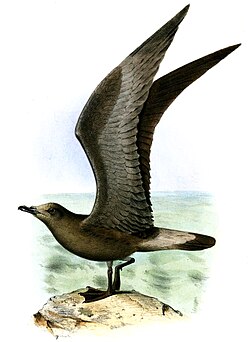Muriwaimanu
| Muriwaimanu Temporal range: Paleocene,
~ | |
|---|---|
| Scientific classification | |
| Kingdom: | Animalia |
| Phylum: | Chordata |
| Class: | Aves |
| Order: | Sphenisciformes |
| Genus: | † Mayr et al., 2018 |
| Species: | †M. tuatahi
|
| Binomial name | |
| †Muriwaimanu tuatahi Mayr et al., 2018
| |
| Synonyms | |
| |
Muriwaimanu is an extinct genus of early penguin from the Paleocene Waipara Greensand of New Zealand. Only the type species M. tuatahi is known.[1]
Etymology
The name Muriwaimanu comes from muri, Māori for "after", and Waimanu, referring to the fact that the fossils come from younger strata than Waimanu.[1]
Discovery and naming
The holotype was discovered in 1980 within the Waipara Greensand near the Waipara River, in Canterbury, New Zealand, and it was initially named Waimanu tuatahi by Slack et al. (2006).[2] Mayr et al. (2018) re-examined the specimen and determined that it belonged to a separate genus, creating the species Muriwaimanu tuatahi.[1]
A second specimen from the Waipara Greensand (CM 2018.124.4), consisting of a partial specimen preserved within two blocks of sandstone, was discovered by Leigh Love in 2017 and was described by Mayr et al. (2020). These researchers identified the specimen as belonging to cf. Muriwaimanu tuatahi.[3] However, later research published by Mayr et al. (2025) assigned this specimen to a new genus and species, Waimanutaha kenlovei, based on phylogenetic separation and proportional differences. In the same publication, the researchers also described specimen UC 22078, which includes a skull, partial mandible, and much of the skeleton, and other specimens referrable to Muriwaimanu.[4]
Description
Muriwaimanu exhibited a long, narrow beak and paddle-shaped wings, and the fossilized remains also indicate it may have kept their wings in a flexed position during downward strokes, unlike modern penguins whose wings are kept extended, suggesting that Muriwaimanu may be a transition species for modern Antarctic penguins.[3]
See also
References
- ^ a b c Gerald Mayr; Vanesa L. De Pietri; Leigh Love; Al A. Mannering; R. Paul Scofield (2018). "A well-preserved new mid-Paleocene penguin (Aves, Sphenisciformes) from the Waipara Greensand in New Zealand". Journal of Vertebrate Paleontology. 37 (6): e1398169. doi:10.1080/02724634.2017.1398169. S2CID 89744522.
- ^ Slack, K.E., Jones, C.M., Ando, T., Harrison G.L., Fordyce R.E., Arnason, U. and Penny, D. (2006). "Early Penguin Fossils, plus Mitochondrial Genomes, Calibrate Avian Evolution." Molecular Biology and Evolution, 23(6): 1144-1155. doi:10.1093/molbev/msj124 PDF fulltext Supplementary Material Archived 2009-12-16 at the Wayback Machine
- ^ a b Mayr, Gerald; De Pietri, Vanesa L.; Love, Leigh; Mannering, Al A.; Bevitt, Joseph J.; Scofield, R. Paul (2020-01-26). "First Complete Wing of a Stem Group Sphenisciform from the Paleocene of New Zealand Sheds Light on the Evolution of the Penguin Flipper". Diversity. 12 (2): 46. doi:10.3390/d12020046. ISSN 1424-2818.
- ^ Mayr, Gerald; De Pietri, Vanesa L.; Proffitt, James; Blokland, Jacob C.; Clarke, Julia A.; Love, Leigh; Mannering, Al A.; Crouch, Erica M.; Reid, Catherine; Scofield, R. Paul (2025-08-12). "Multiple exceptionally preserved fossils from the Paleocene Waipara Greensand inform the diversity of the oldest stem group Sphenisciformes and the formation of their diving adaptations". Zoological Journal of the Linnean Society. 204 (4): zlaf080. doi:10.1093/zoolinnean/zlaf080. ISSN 0024-4082.

